Darrieus Vertical Axis Wind Turbine (VAWT) Performance Enhancement by Means of Gurney Flap
Abstract
1. Introduction
2. Methodology
2.1. Selection of the Airfoil
2.2. Geometric Domain and Boundary Conditions of VAWT
3. Model Sensitivity Analysis
3.1. Numerical Setup and Grid Independence Study (Grid Topology)
3.2. Time Step Size Sensitivity Analysis
3.3. Solution Convergence Analysis
3.4. Model Validation
4. Results and Discussion
4.1. Global Performance Overview
4.2. Torque Distribution Analysis
4.3. Flow Physics Analysis
- Upwind Phase (θ = 90°): At the point of maximum torque generation (Figure 12), both airfoils operate at a high angle of attack. While the GF helps maintain attached flow, it also introduces a parasitic drag penalty. At this specific angle, the small increase in drag slightly counteracts the lift gain, resulting in a net tangential force that is marginally lower than that of the clean airfoil. This explains the slight reduction in the peak instantaneous torque.
- Downwind Phase (θ = 270°): The true advantage of the 0.5%c GF is revealed during the downwind pass. At θ = 270° (Figure 12), the blade moves through turbulent air while experiencing a negative angle of attack, a condition ripe for high drag and negative torque. The clean airfoil exhibits a massive, disorganized, low-velocity wake, which is indicative of significant pressure drag. The 0.5%c GF fundamentally alters this wake structure. It traps a small, stable vortex between the flap and the trailing edge, which helps to stabilize the downstream flow, narrow the wake, and significantly reduce the size of the separated region. This mitigation of pressure drag reduces the negative torque, leading to a higher mean torque over the entire cycle and explaining the 3.21% power improvement at this TSR.
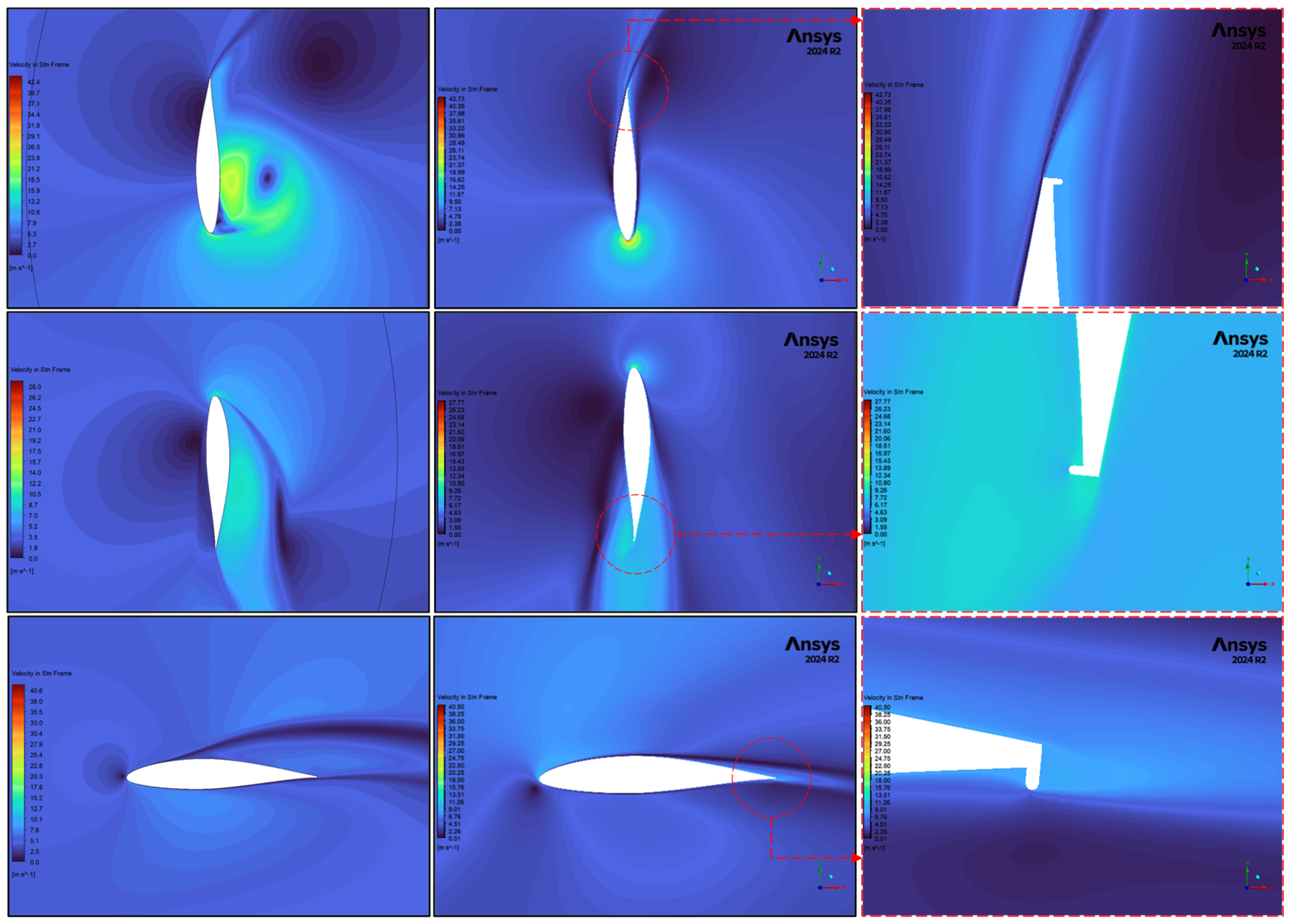
5. Conclusions
- Optimal Configuration Identified: The 0.5%c Gurney flap was unequivocally identified as the most effective and robust configuration, being the only design to provide a consistent power increase across all investigated TSRs.
- Enhanced Startup and Peak Performance: The optimal 0.5%c GF significantly improved the turbine’s self-starting capability, with a 6.30% power increase at TSR = 0.5. It also enhanced the peak performance, achieving a maximum power coefficient (Cp, max) of 0.366 at TSR = 2.0, a 3.73% improvement over the baseline.
- Detrimental Effect of Taller Flaps: Gurney flaps with heights of 1%c and 1.5%c showed inconsistent or negative results. The 1.5%c GF caused a significant power loss of −4.68% at TSR 2.5, demonstrating that beyond an optimal height, the parasitic drag penalty outweighs any lift augmentation benefits.
- Dual Aerodynamic Mechanism: The success of the 0.5%c GF is attributed to a dual mechanism. In the upwind phase, it delays flow separation to increase positive torque at low speeds. In the downwind phase, its primary role is to act as a wake management device, mitigating pressure drag and reducing the negative torque that hinders the clean airfoil.
Author Contributions
Funding
Data Availability Statement
Acknowledgments
Conflicts of Interest
Abbreviations and Nomenclature
| WTs | Wind turbines |
| HAWTs | Horizontal axis wind turbines |
| VAWTs | Vertical axis wind turbines |
| AOA | Angle of Attack |
| GFs | Gurney Flaps |
| 3D | Three-dimensional |
| 2D | Two-dimensional |
| CFD | Computational fluid dynamics |
| TSRs | Tip speed ratios |
| Re | Reynolds number |
| BOIs | Body of influences |
| SST | Shear Stress Transport |
| SIMPLE | Semi-Implicit Method for Pressure Linked Equations |
| c | Chord length |
| Cp | Power coefficient |
| Cm | Torque coefficient |
| V∞ | Free stream velocity |
| θ | Azimuthal angle |
| ° | Degree |
References
- Chen, W.H.; Peng, J.; Bi, X.T. A State-of-the-Art Review of Biomass Torrefaction, Densification and Applications. Renew. Sustain. Energy Rev. 2015, 44, 847–866. [Google Scholar] [CrossRef]
- Eriksson, S.; Bernhoff, H.; Leijon, M. Evaluation of different turbine concepts for wind power. Renewable Sustainable Energy Rev. 2008, 12, 1419–1434. [Google Scholar] [CrossRef]
- Tummala, A.; Velamati, R.K.; Sinha, D.K.; Indraja, V.; Krishna, V.H. A Review on Small Scale Wind Turbines. Renew. Sustain. Energy Rev. 2016, 56, 1351–1371. [Google Scholar] [CrossRef]
- Damota, J.B.; García, J.d.D.R.; Casanova, A.C.; Miranda, J.T.; Caccia, C.G.; Galdo, M.I.L. Analysis of a Nature-Inspired Shape for a Vertical Axis Wind Turbine. Appl. Sci. 2022, 12, 7018. [Google Scholar] [CrossRef]
- Khammas, F.; Hussein Suffer, K.; Usubamatov, R.; Mustaffa, M.T. Overview of Vertical Axis Wind Turbine (VAWT) Is One of the Wind Energy Application. Appl. Mech. Mater. 2015, 793, 388–392. [Google Scholar] [CrossRef]
- Johari, M.K.; Azim, M.; Jalil, A.; Faizal, M.; Shariff, M. Comparison of Horizontal Axis Wind Turbine (HAWT) and Vertical Axis Wind Turbine (VAWT). Int. J. Eng. Technol. 2018, 7, 74–80. [Google Scholar] [CrossRef]
- Mccroskey, W.J. The Phenomenon of Dynamic Stall; Technical Report NASA-TM-81264, 4 September 2013; NASA: Washington, DC, USA, 2013. [Google Scholar]
- Chakroun, Y.; Bangga, G. Aerodynamic Characteristics of Airfoil and Vertical Axis Wind Turbine Employed with Gurney Flaps. Sustainability 2021, 13, 4284. [Google Scholar] [CrossRef]
- Carr, L.W. Progress in Analysis and Prediction of Dynamic Stall. J. Aircr. 1988, 25, 6–17. [Google Scholar] [CrossRef]
- Rezaeiha, A.; Montazeri, H.; Blocken, B. Towards Optimal Aerodynamic Design of Vertical Axis Wind Turbines: Impact of Solidity and Number of Blades. Energy 2018, 165, 1129–1148. [Google Scholar] [CrossRef]
- Kumar, R.; Raahemifar, K.; Fung, A.S. A Critical Review of Vertical Axis Wind Turbines for Urban Applications. Renew. Sustain. Energy Rev. 2018, 89, 281–291. [Google Scholar] [CrossRef]
- Worasinchai, S.; Ingram, G.L.; Dominy, R.G. The Physics of H-Darrieus Turbine Starting Behavior. J. Eng. Gas. Turbine Power 2016, 138, 062605. [Google Scholar] [CrossRef]
- Syawitri, T.P.; Yao, Y.; Yao, J.; Chandra, B. A Review on the Use of Passive Flow Control Devices as Performance Enhancement of Lift-Type Vertical Axis Wind Turbines. Wiley Interdiscip. Rev. Energy Environ. 2022, 11, e435. [Google Scholar] [CrossRef]
- Wong, K.H.; Chong, W.T.; Sukiman, N.L.; Poh, S.C.; Shiah, Y.C.; Wang, C.T. Performance Enhancements on Vertical Axis Wind Turbines Using Flow Augmentation Systems: A Review. Renew. Sustain. Energy Rev. 2017, 73, 904–921. [Google Scholar] [CrossRef]
- Mousavi, M.; Masdari, M.; Tahani, M. Power Performance Enhancement of Vertical Axis Wind Turbines by a Novel Gurney Flap Design. Aircr. Eng. Aerosp. Technol. 2022, 94, 482–491. [Google Scholar] [CrossRef]
- Liebeck, R.H. Design of Subsonic Airfoils for High Lift. J. Aircr. 1978, 15, 547–561. [Google Scholar] [CrossRef]
- Brusca, S.; Cucinotta, F.; Galvagno, A.; Sfravara, F.; Chillemi, M. Development of a Numerical Characterization Method for a Ducted Savonius Turbine with Power Augmenters. Energies 2025, 18, 1142. [Google Scholar] [CrossRef]
- Das Karmakar, S.; Chattopadhyay, H. A Review of Augmentation Methods to Enhance the Performance of Vertical Axis Wind Turbine. Sustain. Energy Technol. Assess. 2022, 53, 102469. [Google Scholar] [CrossRef]
- Lee, K.Y.; Cruden, A.; Ng, J.H.; Wong, K.H. Variable Designs of Vertical Axis Wind Turbines—A Review. Front. Energy Res. 2024, 12, 1437800. [Google Scholar] [CrossRef]
- Mayda, E.A.; Van Dam, C.P.; Yen Nakafuji, D. Computational Investigation of Finite Width Microtabs for Aerodynamic Load Control. In Proceedings of the Collection of the 2005 ASME Wind Energy Symposium Technical Papers at the 43rd AIAA Aerospace Sciences Meeting and Exhibit, Reno, NV, USA, 10–13 January 2005; American Institute of Aeronautics and Astronautics Inc.: Reston, VA, USA, 2005; pp. 424–436. [Google Scholar]
- Syawitri, T.P.; Yao, Y.; Yao, J.; Chandra, B. Geometry Optimisation of Vertical Axis Wind Turbine with Gurney Flap for Performance Enhancement at Low, Medium and High Ranges of Tip Speed Ratios. Sustain. Energy Technol. Assess. 2022, 49, 101779. [Google Scholar] [CrossRef]
- Xie, Y.H.; Jiang, W.; Lu, K.; Zhang, D. Numerical Investigation into Energy Extraction of Flapping Airfoil with Gurney Flaps. Energy 2016, 109, 694–702. [Google Scholar] [CrossRef]
- Yan, Y.; Avital, E.; Williams, J.; Cui, J. Aerodynamic Performance Improvement of Vertical Axis Wind Turbines through Novel Techniques. J. Wind. Eng. Ind. Aerodyn. 2021, 211, 104535. [Google Scholar] [CrossRef]
- Giguère, P.; Lemay, J.; Dumas, G. Gurney Flap Effects and Scaling for Low-Speed Airfoils. In Proceedings of the 13th Applied Aerodynamics Conference, San Diego, CA, USA, 19–22 June 1995; American Institute of Aeronautics and Astronautics Inc.: Reston, VA, USA, 1995; pp. 966–976. [Google Scholar]
- Li, Y.C.; Wang, J.J.; Tan, G.K.; Zhang, P.F. Effects of Gurney Flaps on the Lift Enhancement of a Cropped Nonslender Delta Wing. Exp. Fluids 2002, 32, 99–105. [Google Scholar] [CrossRef]
- Jain, S.; Sitaram, N.; Krishnaswamy, S. Computational Investigations on the Effects of Gurney Flap on Airfoil Aerodynamics. Int. Sch. Res. Not. 2015, 2015, 402358. [Google Scholar] [CrossRef] [PubMed]
- Yan, Y.; Avital, E.; Williams, J.; Cui, J. Performance Improvements for a Vertical Axis Wind Turbine by Means of Gurney Flap. J. Fluids Eng. Trans. ASME 2020, 142, 021205. [Google Scholar] [CrossRef]
- Liu, Q.; Miao, W.; Ye, Q.; Li, C. Performance Assessment of an Innovative Gurney Flap for Straight-Bladed Vertical Axis Wind Turbine. Renew. Energy 2022, 185, 1124–1138. [Google Scholar] [CrossRef]
- Rezaeiha, A.; Montazeri, H.; Blocken, B. Characterization of Aerodynamic Performance of Vertical Axis Wind Turbines: Impact of Operational Parameters. Energy Convers. Manag. 2018, 169, 45–77. [Google Scholar] [CrossRef]
- Didane, D.H.; Behery, M.R.; Al-Ghriybah, M.; Manshoor, B. Recent Progress in Design and Performance Analysis of Vertical-Axis Wind Turbines—A Comprehensive Review. Processes 2024, 12, 1094. [Google Scholar] [CrossRef]
- Ullah, H.; Huang, Y.; Gulizzi, V.; Pantano, A. To Enhance the Aerodynamic Power Efficiency of Vertical Axis Wind Turbines: Proposing Morphing Strategies for Variable Wind Speed. Machines 2025, 13, 739. [Google Scholar] [CrossRef]
- Alaimo, A.; Esposito, A.; Messineo, A.; Orlando, C.; Tumino, D. 3D CFD Analysis of a Vertical Axis Wind Turbine. Energies 2015, 8, 3013–3033. [Google Scholar] [CrossRef]
- Zhang, L.; Gu, J.; Hu, K.; Zhu, H.; Miao, J.; Li, X.; Ma, D.; Mi, Y.; Wang, Z. Influences of Trailing Edge Split Flap on the Aerodynamic Performance of Vertical Axis Wind Turbine. Energy Sci. Eng. 2021, 9, 101–115. [Google Scholar] [CrossRef]
- Ekaterinaris, J.A.; Platzer, M.F. Computational Prediction of Airfoil Dynamic Stall. Prog. Aerosp. Sci. 1997, 33, 759–846. [Google Scholar] [CrossRef]
- Kord, K.; Bazargan, M. Numerical Investigation on J-Shaped Straight-Bladed Darrieus Vertical Axis Wind Turbines Equipped with Gurney Flaps. Int. J. Energy Res. 2024, 2024, 8992210. [Google Scholar] [CrossRef]
- Moshizi, S.A.; Madadi, A.; Kermani, M.J. Comp Arison of Inviscid and Viscous Transonic Flow Field in VKI Gas Turbine Blade Cascade. Alex. Eng. J. 2014, 53, 275–280. [Google Scholar] [CrossRef]
- Langtry, R.B.; Gola, J.; Menter, F.R. Predicting 2D Airfoil and 3D Wind Turbine Rotor Performance Using a Transition Model for General CFD Codes. In Proceedings of the 44th AIAA Aerospace Sciences Meeting and Exhibit, Reno, NV, USA, 9–12 January 2006. [Google Scholar]
- Mclaren, K.W. A Numerical and Experimental Study of Unsteady Loading of High Solidity Vertical Axis Wind Turbines. Ph.D. Thesis, McMaster University, Hamilton, ON, Canada, 2011. [Google Scholar]
- Raciti Castelli, M.; Englaro, A.; Benini, E. The Darrieus Wind Turbine: Proposal for a New Performance Prediction Model Based on CFD. Energy 2011, 36, 4919–4934. [Google Scholar] [CrossRef]


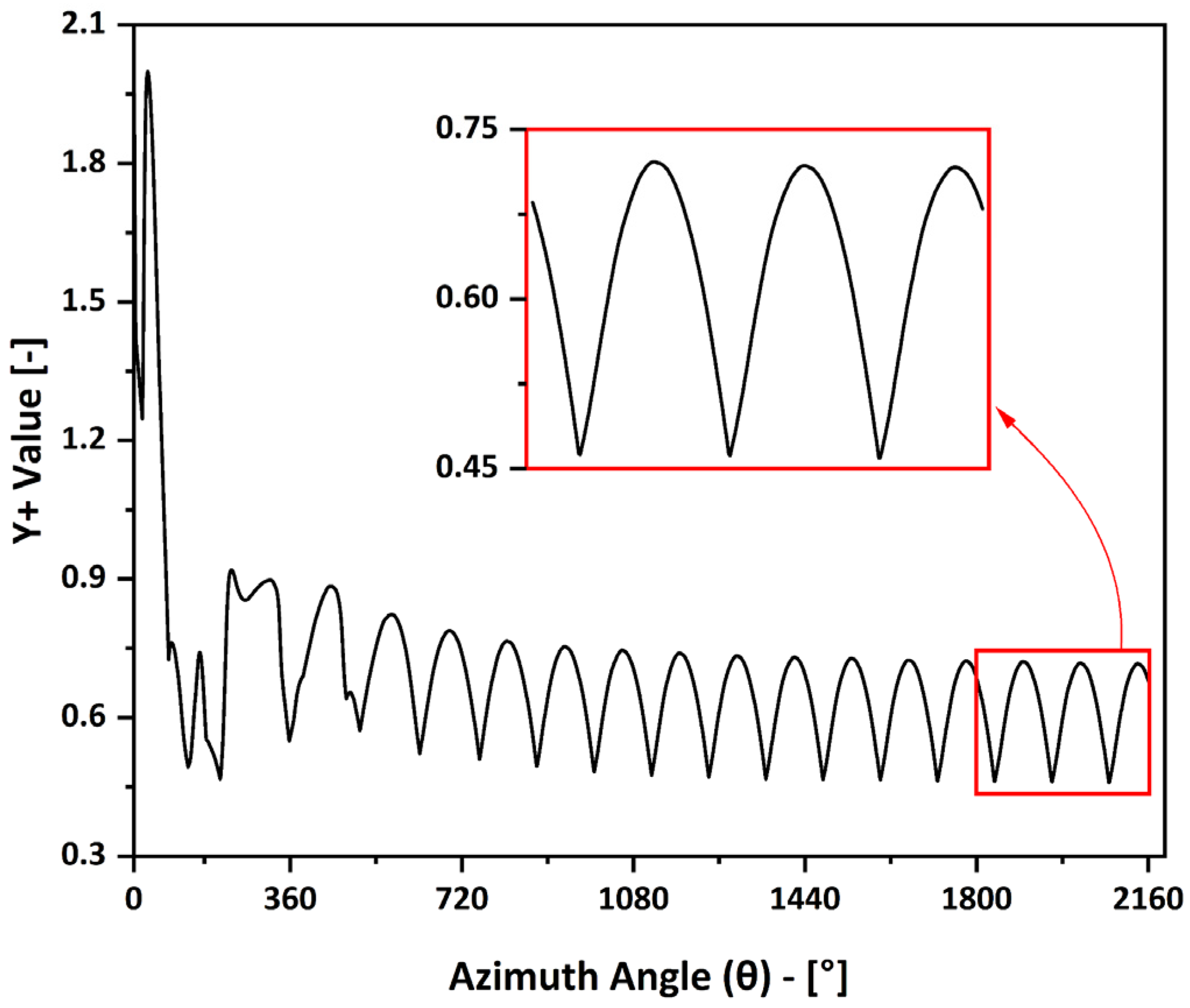




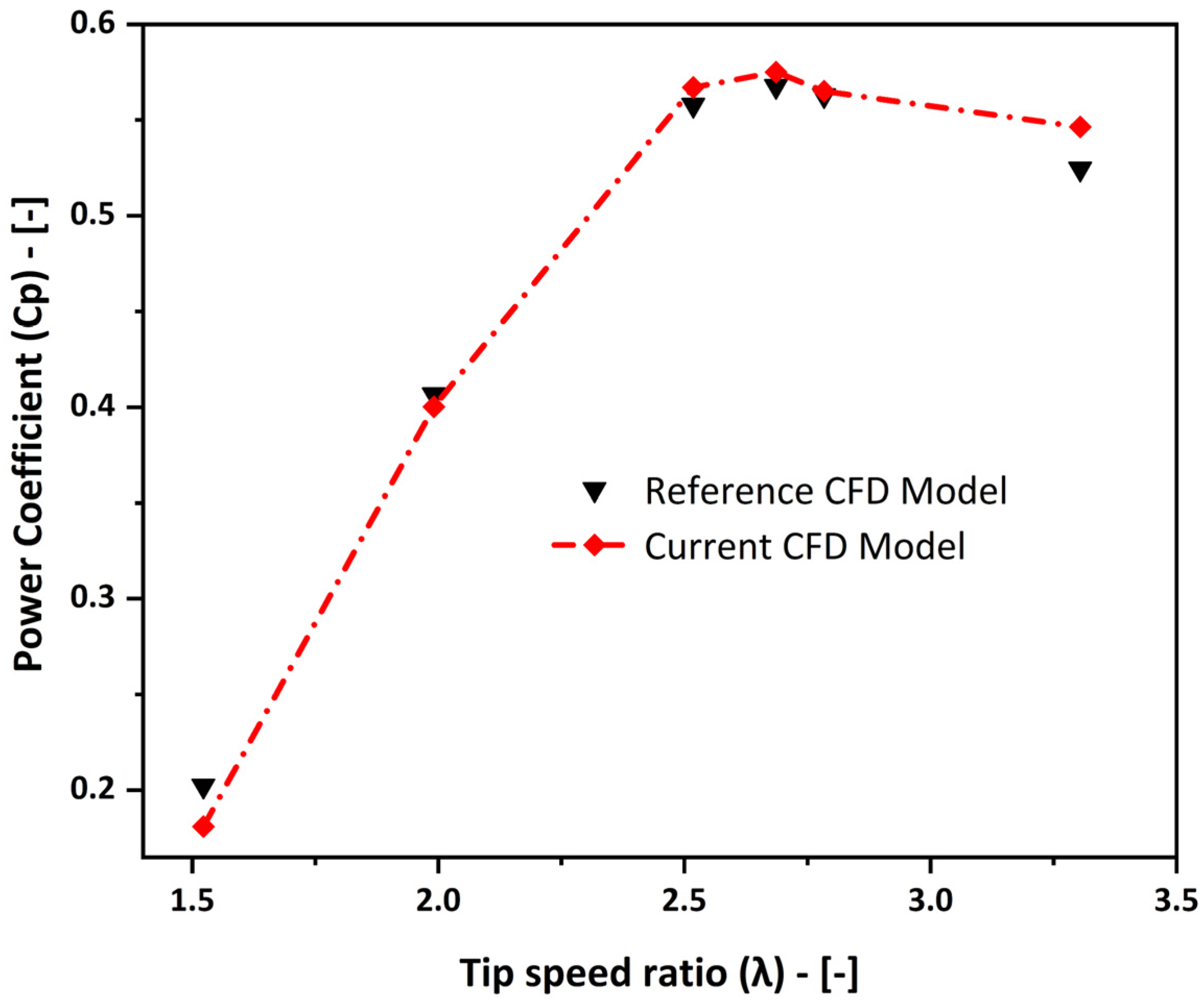
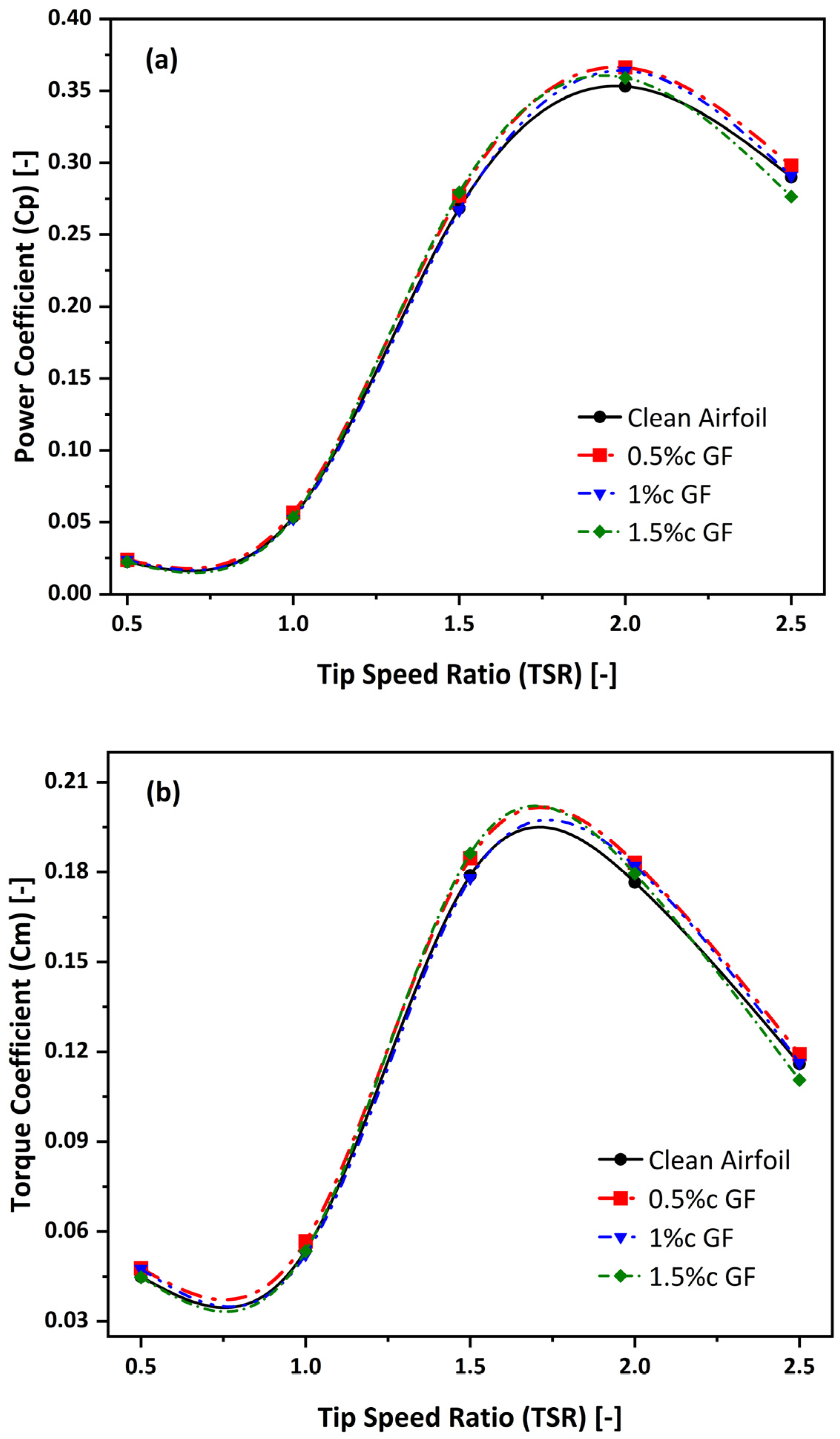
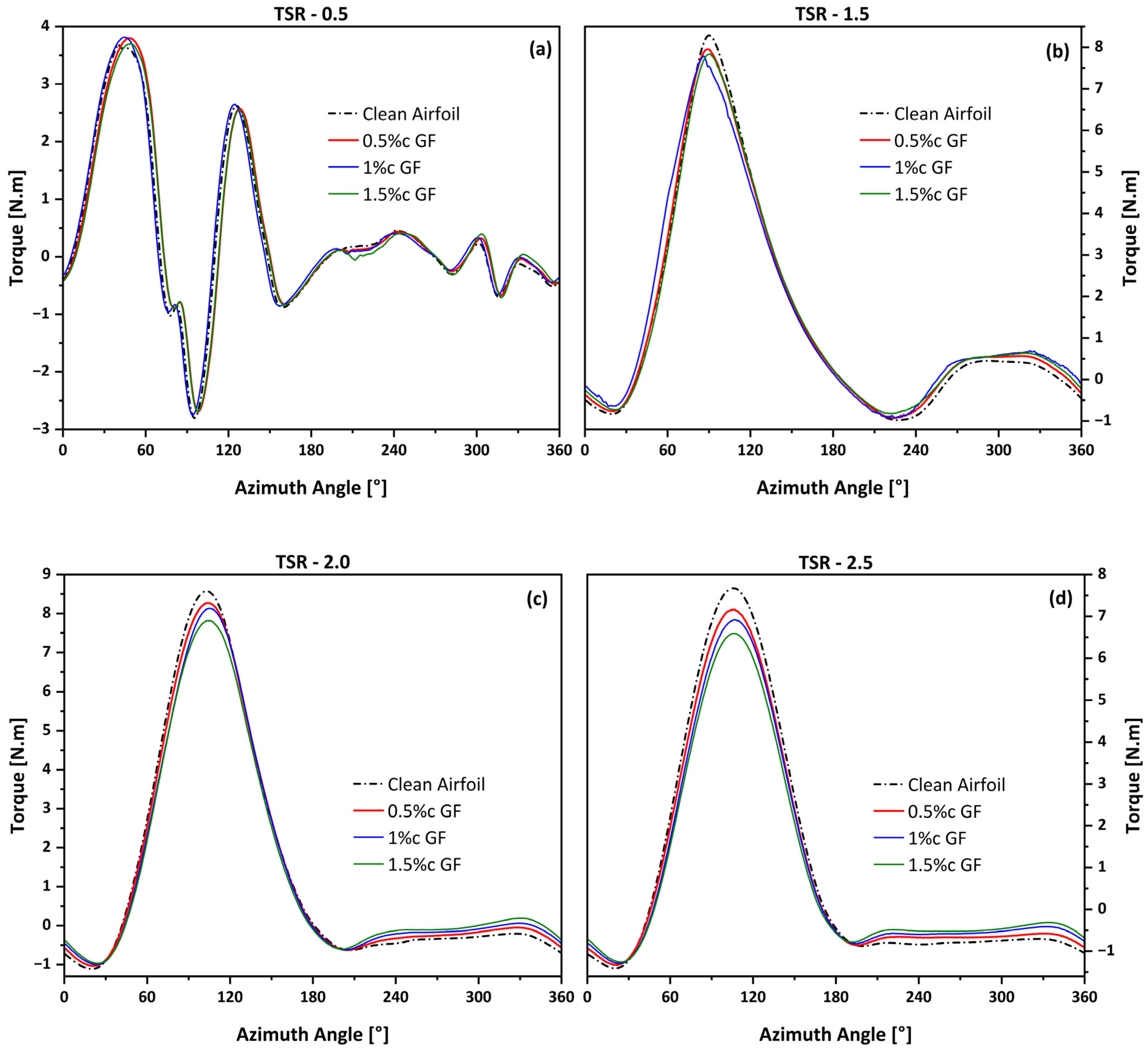

| Parameters | Notation | Value | Measure |
|---|---|---|---|
| Geometric and Design parameters | |||
| Airfoil profile | - | NACA 64(2)-415 | - |
| Chord length | c | 0.25 | m |
| Rotor radius | Rrotor | 0.725 | m |
| Rotor diameter | Drotor | 1.45 | m |
| Height | H | 1 (2D) | m |
| Number of blades | N | 3 | - |
| Gurney flaps | GFs | 0.5, 1.0, 1.5 | %c |
| Operational parameters | |||
| Wind speed | V | 6 | m/s |
| TSRs | λ | 0.5–2.5 | - |
| Reynolds Number | Re | 1.03 × 105 | - |
| Grid | No. of Divisions on Blade | No. of Boundary Layers | Growth Rate | Total Number of Elements | Average Torque Coefficient | Derivation (%) |
|---|---|---|---|---|---|---|
| Coarse | 450 | 35 | 1.1 | 267,554 | 0.1103 | -- |
| Medium | 900 | 35 | 1.1 | 537,820 | 0.1283 | 14 |
| Fine | 1800 | 35 | 1.05 | 747,154 | 0.1324 | 3.09 |
| Very fine | 3600 | 35 | 1.05 | 1,116,676 | 0.1313 | 0.83 |
| Time Step Size (°) | Average Torque Coefficient | Derivation (%) |
|---|---|---|
| 0.5 | 0.1315 | --- |
| 1 | 0.1324 | 0.69 |
| 2 | 0.1408 | 6.39 |
| Parameters | Notation | Value | Measure |
|---|---|---|---|
| Airfoil profile | - | NACA0021 | - |
| Number of blades | N | 3 | - |
| Rotor diameter | Drotor | 1030 | mm |
| Rotor height | H | 1 (2D) | mm |
| Chord length | c | 85.8 | mm |
| Solidity | σ | 0.5 | - |
| TSRs | Configuration | Mean Torque Coefficient (Cm) | Mean Power Coefficient (Cp) | Change in GFs vs. Clean Airfoil (%) |
|---|---|---|---|---|
| 0.5 | Clean Airfoil | 0.0449 | 0.0224 | Baseline |
| 0.5%c GF | 0.0477 | 0.0239 | +6.30% | |
| 1%c GF | 0.0475 | 0.0238 | +5.80% | |
| 1.5%c GF | 0.0447 | 0.0224 | −0.40% | |
| 1.5 | Clean Airfoil | 0.1789 | 0.2683 | Baseline |
| 0.5%c GF | 0.1846 | 0.2769 | +3.21% | |
| 1%c GF | 0.1779 | 0.2669 | −0.52% | |
| 1.5%c GF | 0.1862 | 0.2794 | +4.13% | |
| 2.0 | Clean Airfoil | 0.1765 | 0.3531 | Baseline |
| 0.5%c GF | 0.1831 | 0.3663 | +3.73% | |
| 1%c GF | 0.1820 | 0.3640 | +3.09% | |
| 1.5%c GF | 0.1795 | 0.3590 | +1.66% | |
| 2.5 | Clean Airfoil | 0.1160 | 0.2900 | Baseline |
| 0.5%c GF | 0.1192 | 0.2980 | +2.75% | |
| 1%c GF | 0.1163 | 0.2908 | +0.29% | |
| 1.5%c GF | 0.1106 | 0.2764 | −4.68% |
Disclaimer/Publisher’s Note: The statements, opinions and data contained in all publications are solely those of the individual author(s) and contributor(s) and not of MDPI and/or the editor(s). MDPI and/or the editor(s) disclaim responsibility for any injury to people or property resulting from any ideas, methods, instructions or products referred to in the content. |
© 2025 by the authors. Licensee MDPI, Basel, Switzerland. This article is an open access article distributed under the terms and conditions of the Creative Commons Attribution (CC BY) license (https://creativecommons.org/licenses/by/4.0/).
Share and Cite
Ullah, H.; Gulizzi, V.; Pantano, A.; Deng, Z.; Xiao, Q. Darrieus Vertical Axis Wind Turbine (VAWT) Performance Enhancement by Means of Gurney Flap. Machines 2025, 13, 1004. https://doi.org/10.3390/machines13111004
Ullah H, Gulizzi V, Pantano A, Deng Z, Xiao Q. Darrieus Vertical Axis Wind Turbine (VAWT) Performance Enhancement by Means of Gurney Flap. Machines. 2025; 13(11):1004. https://doi.org/10.3390/machines13111004
Chicago/Turabian StyleUllah, Hanif, Vincenzo Gulizzi, Antonio Pantano, Zhongsheng Deng, and Qing Xiao. 2025. "Darrieus Vertical Axis Wind Turbine (VAWT) Performance Enhancement by Means of Gurney Flap" Machines 13, no. 11: 1004. https://doi.org/10.3390/machines13111004
APA StyleUllah, H., Gulizzi, V., Pantano, A., Deng, Z., & Xiao, Q. (2025). Darrieus Vertical Axis Wind Turbine (VAWT) Performance Enhancement by Means of Gurney Flap. Machines, 13(11), 1004. https://doi.org/10.3390/machines13111004








